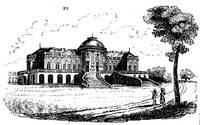341. Solitude is, or rather was, another extravagant absurdity of the Ludwigsburg school; and, that we may not be accused of misrepresentation when speaking of it, we shall devote ample space to an engraving of the plan (fig. 87. p. 132, 133.). It may do good as a warning; and we think will cure any who may have a lingering hankering after the antiquated royal gardens. This palace was built in a great hurry, between the years 1703 and 1767, during the time of the Archduke Charles who, however, could not raise money enough to finish all its appendages and details. It is situated on high table-land in the midst of a very extensive forest, consisting chiefly of beech; but with oaks, spruce firs, pines, birches, and trembling poplars intervening occasionally. This natural forest is now what it has always been; but of the ancient gardens there is scarcely a trace remaining. The palace, or lust-haus (pleasure-house). may be described as resembling that of Mon Repos (ᄎ 343.), but upon a larger scale (fig, 88.), It exhibits the same surrounding arcade, surmounted by a broad terrace and ascended by a ramp, with the same cupola in the centre. The architecture, however, is in worse taste; it is covered with painted and gilt ornaments of the most tawdry description; which, with the wooden balustrades, are now fast falling to decay. The rain, in 1828, was falling through the roof in a great many places, and rotting the painted and richly gilt ceilings and cornices, and the miserable remains of the once costly furniture and pictures. If the effect of solitude can be heightened by desolation, the whole may be said to be in excellent keeping. There is, however, one fine feature of tins place, which must not be forgotten; and that is, the prospects which extend in all directions from the terrace. The extent of these prospects will be understood, when we mention, that the situation of Solitude is nearly 2000 feet above the level of the sea; and that the country falls from it, though gently, on every side. For miles around the palace, this country is covered with forest, which forms a foreground to upwards of sixty towns and villages seen in the distance. But the finest view is that towards the palace of Ludwigsburg, along an avenue of several miles in length, distinctly seen from one end to the other. This avenue descends into a broad valley, and rises again on the opposite side, till it reaches Ludwigsburg, in a truly magnificent manner. This and the other long straight avenues which are found in these grounds, form their redeeming points, and would have a still better effect than they have, were they not intersected by so many shorter avenues. Long straight avenues have always a majestic appearance, and produce ideas of splendour and luxury, as they can only be produced in places of great extent, and cannot possibly be imitated on a small scale. The numerous parterres, however, with which the grounds of Solitude are crowded, may be exactly imitated in places of very small extent, and by proprietors of very limited means. As they can only be seen in detail, they give no ideas of grandeur and magnificence, and instead of appearing like parts of a great whole, they give rather the idea of a number of small suburban gardens closely adjoining each other. The immense number of ponds in this garden is characteristic of the German style, as the landscape-gardeners of Germany generally consider water to be the 'life and soul of a garden. '

